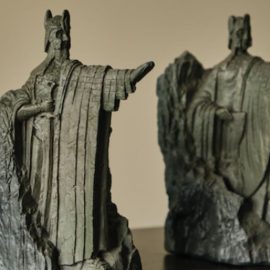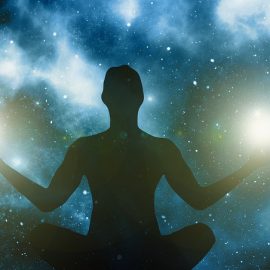

This article is an excerpt from the Shortform book guide to "Autobiography of a Yogi" by Paramahansa Yogananda. Shortform has the world's best summaries and analyses of books you should be reading.
Like this article? Sign up for a free trial here.
Curious to learn about Paramahansa Yogananda’s teachings? What schools did he open? What is the Self-Realization Fellowship?
Paramahansa Yogananda was a renowned yogi who founded schools that combined spiritual and practical education. Yogananda’s teachings, which explained the science of kriya yoga, aimed to bridge the gap between Eastern and Western cultures.
Read on to learn about Yogananda’s teachings, including the schools he founded during his lifetime.
The Legacy of Yogananda’s Teachings
Paramahansa Yogananda explains in his memoir, Autobiography of a Yogi, that once he had become an accomplished yogi, his mission in life was far from over. Yogananda’s teachings are part of his legacy, and he says that throughout his life, he’d received visions of three different buildings. While studying with his mentor Sri Yukteswar Giri, he came to understand that these were three schools he would found.
The first third of his vision came true when he founded the Yogoda Satsanga Society of India in 1917, near the city of Ranchi. However, it would be many years before the other two schools from his visions became reality.
Yogananda says that his schools combined spiritual and practical education, much like his own teaching with Yukteswar did. The school in Ranchi, for example, taught students academic subjects like math and literature, along with offering classes in agriculture, industrial job training, and business.
(Shortform note: The Yogoda Satsanga Society (YSS) still exists today, and it teaches kriya yoga to people of all backgrounds and religions. The YSS now has four separate ashrams and hundreds of smaller facilities throughout India and the surrounding countries. The organization also upholds Yogananda’s belief that practical and religious teaching are both beneficial in seeking God. One of the YSS’s goals is to unite science and religion by showing that they have the same fundamental principle: the search for truth.)
Even when teaching yoga, Yogananda couched his lessons in practical terms—he taught what he calls the science of kriya yoga, which explains yoga’s seemingly impossible effects using biology and physics. For example, he taught that the human body functions much like a battery; certain yoga techniques connect you with God’s infinite energy to recharge that battery, thereby explaining why some yogis don’t seem to need sleep.
Sri Yukteswar foretold that this well-rounded approach to teaching yoga would bridge the gap between Eastern and Western cultures—people who would normally be skeptical about spiritual practices would listen to a college-educated man explaining those practices and their benefits in scientific terms.
| Evaluating the Science Behind Ideas in Yoga Using scientific terms and principles to explain spiritual topics is a fairly common practice, but nonscientists may use these terms differently from their formal scientific definitions. This is often referred to as pseudoscience: something that appears to be science but actually isn’t. For instance, when Yogananda says that the body stores and uses energy, in one sense, that’s scientifically accurate: The body uses energy that it extracts from food and stores excess food as fat. However, Yogananda was actually talking about a different form of cosmic, spiritual energy that can’t be observed or measured in any way. Note that science requires data: Theories must be testable, and the results of those tests must be repeatable. Therefore, because there’s no way to test Yogananda’s claims about spiritual energy and yogis’ abilities to forgo sleep, those claims can’t be described as truly backed by science, regardless of whether he uses scientific language to describe them. |
Yogananda Fulfilling His Destiny
By this time, Yogananda explains, he fully understood the destiny that Lahiri Mahasaya had foretold for him: He would bring yoga to the West, teaching and guiding thousands of people. So, after the Congress of Religious Liberals ended, Yogananda stayed in the US, and California became his home for the rest of his life.
(Shortform note: Although Yogananda officially made his home in California, he spent the next 10 years traveling all over the US to share his teachings and presentations about yoga. In fact, he spoke at many of the largest auditoriums in the country during this time, and these venues were frequently filled to capacity.)
In 1925, Yogananda founded the headquarters of the Self-Realization Fellowship—a global branch of the YSS—in Los Angeles, California. The headquarters was the second of the three buildings he’d seen in his visions.
(Shortform note: In the mid-1930s, Yogananda reduced his traveling and teaching to focus on growing and guiding the YSS and the Self-Realization Fellowship. Yogananda compiled his teachings into a series of lessons that people could continue to study after his death, and he developed a retreat program that the Fellowship still uses. Today, the Self-Realization Fellowship consists of more than 500 temples, ashrams, and schools all over the world.)
Yogananda notes that he visited his home country of India in 1935. While he was there, Yukteswar granted him the title Paramahansa—the highest honor a yogi can earn—to commemorate his spiritual achievements.
(Shortform note: Paramahansa translates to “supreme swan” and indicates someone who’s achieved enlightenment. The title comes from a myth about a swan that was able to drink only the milk from a solution of milk and water. Just as that swan could separate the milk from the water, a Paramahansa can separate the real (God) from the illusory (maya).)
Yogananda traveled back to America in 1937. He says that upon returning, he found that his students had founded an ashram for the Self-Realization Fellowship in Encinitas, California, near the coast. What his students had intended as a pleasant surprise was, in fact, the fulfillment of the final part of Yogananda’s vision: an ashram by the sea, the third building he’d foreseen.
(Shortform note: The Encinitas ashram is much more than just a religious retreat: It’s a tourist attraction, a concert venue, and a nature reserve as well. Yogananda spent much of the remainder of his life at this ashram; in fact, it’s where he wrote Autobiography of a Yogi.)

———End of Preview———
Like what you just read? Read the rest of the world's best book summary and analysis of Paramahansa Yogananda's "Autobiography of a Yogi" at Shortform.
Here's what you'll find in our full Autobiography of a Yogi summary:
- The memoir of Paramahansa Yogananda, a famous yoga practitioner and teacher
- Practical lessons about yoga, spirituality, and how to live a good life
- An explanation of the Eightfold Path of Yoga






